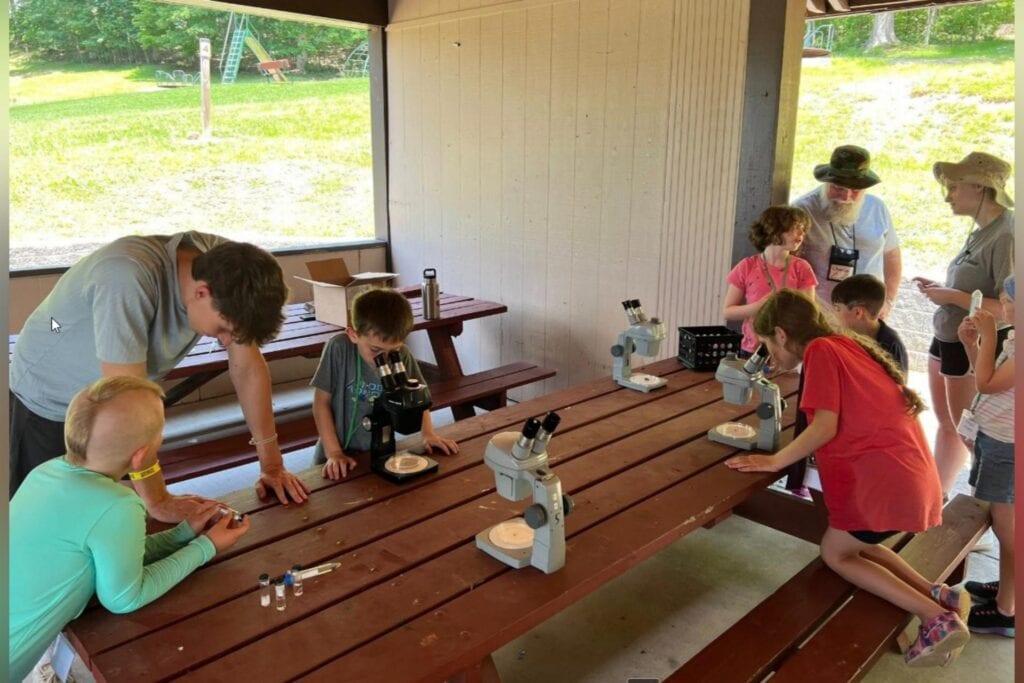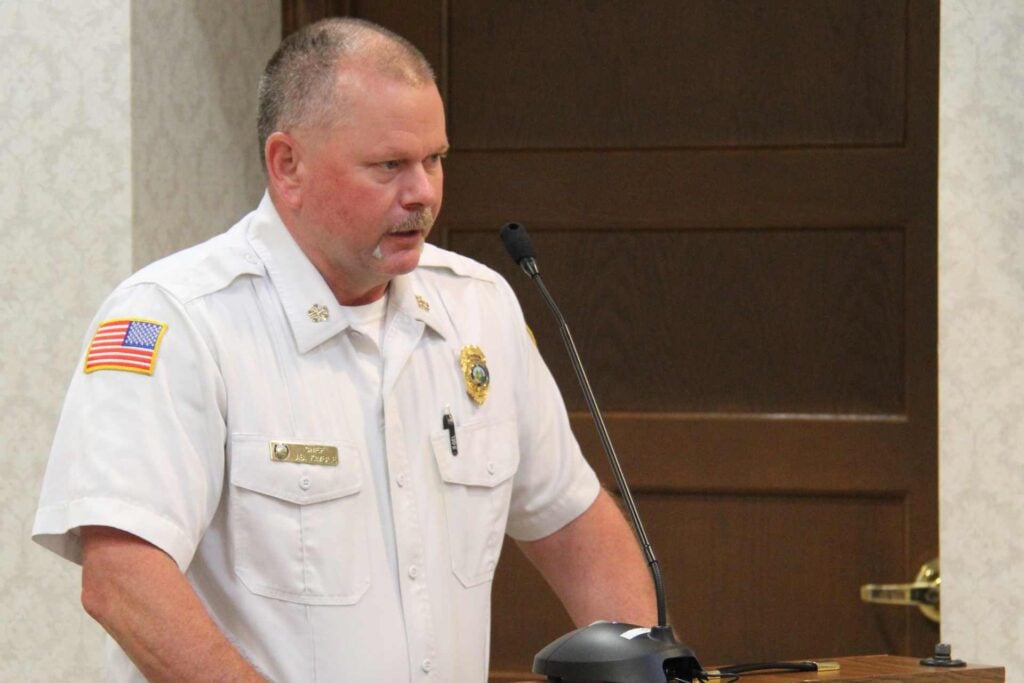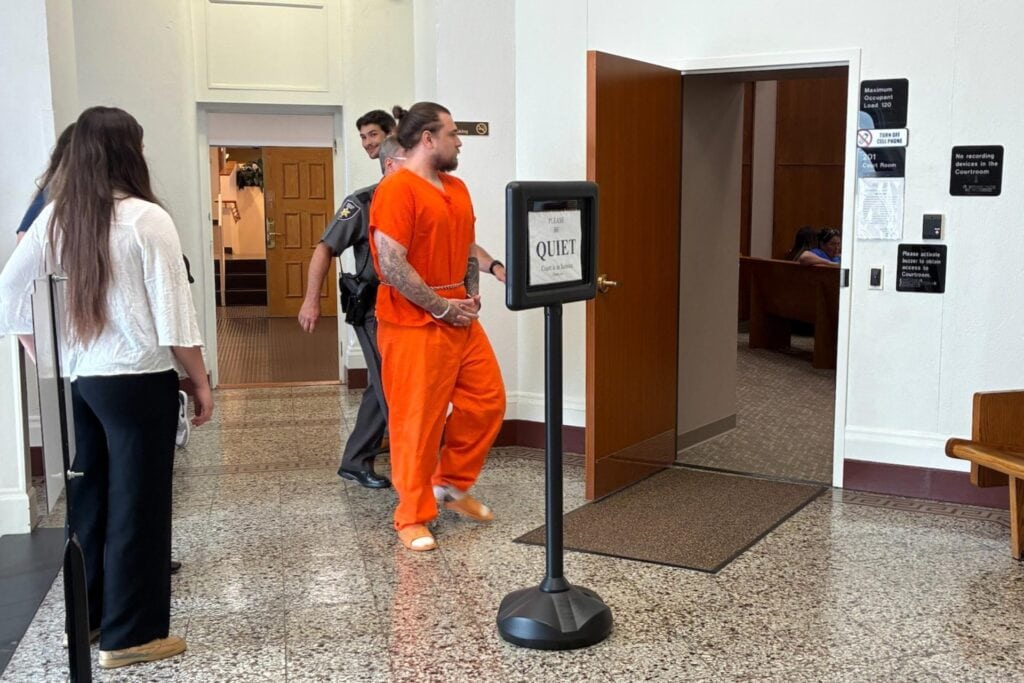Editor’s note: This story was originally published by Mountain State Spotlight. Get stories like this delivered to your email inbox once a week; sign up for the free newsletter at https://mountainstatespotlight.org/newsletter
It’s usually not a good sign when several crews of West Virginia emergency workers are on the scene. Crews are such a scarce resource, especially during the COVID-19 pandemic, that having them tied up at the same spot must mean it’s a life-or-death emergency.
In a way, that’s what it was at the state Capitol Wednesday morning as representatives from roughly a dozen county Emergency Medical Services agencies gathered for an official “EMS Day.” With tables full of free swag and poster boards, it felt as if it was as much of a networking or conference event as it was an opportunity to meet with legislators.
But underneath that was a tone of deep uncertainty, reflective of the long-term struggles of these county agencies to retain workers, stay financially stable and keep providing vital services to West Virginians.
At one of the tables, the Mason County EMS agency included a breakdown on the costs to buy lifesaving equipment. A few tables down, the Boone County Ambulance Authority included a presentation on the past, present and future of EMS. The future side was blank.
“We’re all coming here together and saying we need help,” said Bryan Justice, director of the Boone County agency. “Kind of like the board that we put together for today’s event. …And if you notice on that board, the future doesn’t have any pictures on it because it’s kind of an uncertain time right now for EMS.”
While the EMS agencies’ struggles aren’t new, the pandemic worsened the situation. For the past two years, COVID burnout, low pay and difficult conditions have driven EMS workers away from their jobs, and in some cases left state residents without reliable emergency services. The agencies haven’t been shy about sounding the alarm, but have gained little traction.
This year, there’s a sense of optimism. The Legislature and the governor have paid more attention to the plight of struggling EMS agencies in recent months, and Bryan Justice and others say they feel like they’re being listened to. But as the end of the legislative session nears, lawmakers haven’t taken action to address the long-term EMS funding problems.
Same EMS challenges persist
Like other parts of West Virginia’s health and public safety systems, COVID-19 exposed longstanding challenges for EMS agencies. Entry-level EMS workers can start off between $12 and $15 an hour, which isn’t competitive in some areas. Last year, Justice said his Boone County agency was competing for workers with both local chain restaurants and out-of-state EMS agencies.
Now, he says, his county has gotten to the point where he’s only short one crew member. But that, in turn, has left vacancies in other counties.
“While our agency has picked up a few to get to full staff, they’ve left other agencies and now that agency is where we were. And that’s the revolving door of EMS,” he said.
Next door in Lincoln County, EMS Director Trish Watson says they’re down 14 people compared to pre-pandemic.
“That means currently that we are recruiting really hard. We are having to run a lot of overtime, which is obviously an expense that you don’t plan for,” she said. “We’re still able to make the calls but we are getting concerned. You know what point are we going to end up having to shut down a truck?”
Adding to the staffing issues are other long-term issues like low reimbursement rates for Medicare and Medicaid that hardly cover the cost of supplies, let alone crew salaries. Mason County EMS Director Elisabeth Lloyd pointed to a billing breakdown for an average heart attack call. Not taking into account salaries, her agency gets reimbursed less than half of what it costs in just supplies to treat and transport a patient having a heart attack.
“We do a lot for very little,” she said. “Our billing — what we charge and what we actually get — is minimal. It doesn’t even pay for supplies. We have to have funding.”
Directors say Medicaid and Medicare cover the majority of EMS patients in the state, but reimburse at far lower rates than private insurances. They say the federal government would need to address the issue for Medicare. But West Virginia has the authority to increase reimbursements for Medicaid.
Lawmakers and EMS directors agree that financial stability is the root problem here. EMS agencies are funded primarily in three ways. Counties can allocate money to agencies in the annual budget, additional levies can be approved by voters, and reimbursements from services provided. Even agencies funded by levies are at risk in the state’s counties that have experienced jobs and population loss, such as Boone County.
“There’s no real consistency across the state of how funding occurs. And so you end up with a broken funding system,” said Delegate Clay Riley, R-Harrison, vice chair of the Committee on Fire Departments and Emergency Medical Services. “And you have some counties who maybe have had more success who don’t have as much issue and you have other counties who are ready to put the keys on the table because they just don’t have it.”
Riley noted some other possible problems lawmakers could address, including a statewide job board for postings and a loophole that means EMS agencies don’t get paid if they make a call and don’t end up transporting a patient. Committee Chairman Joe Statler, R-Monongalia, said the committee is still only a few years old and has no companion committee in the Senate, so it’s been a challenge crafting legislation. Until recently, the focus was more on fire departments, but members are switching gears to try and understand the problems EMS agencies are facing, he said.
The West Virginia EMS Coalition has also tried to offer solutions, publishing a report with examples of how surrounding states fund EMS. But lawmakers didn’t introduce any of these ideas or long-term solutions this year.
Looking forward
Instead of addressing these issues, lawmakers have focused on a bill that would promote the Office of Emergency Services to its own agency within the executive branch.
On Wednesday, the EMS workers at the Capitol left their booths around noon and walked in unison to the Senate gallery to hear the final passage of the bill.
OEMS, housed within the Department of Health and Human Resources, is tasked with inspecting EMS departments, issuing policies, and providing technical support and infrastructure. The office’s director was suspended in December. EMS directors agree that stabilizing that office should be a priority.
On the floor, the bill’s lead sponsor, Sen. Eric Tarr, R-Putnam, said the inspiration for the bill came after hearing from EMS leaders. He had harsh words for the current state of the office.
“It’s reaching such a crisis situation that [EMS leaders are] worried about the lives that are risked and also the harm that can be done by an ambulance not being able to show up when it should,” Tarr said.
“Looking at just trying to problem solve, it became very apparent that much of the problem is created from a complete failure of strategic leadership within the Department of Health and Human Resources to address this problem. And while lip service appeared to be paid to it, I could see absolutely nothing in the plan that was going to produce a solution for the EMS crisis.”
A DHHR spokesperson didn’t return a request for comment on the measure, which passed.
The EMS workers in the gallery expected to watch the passage of another bill that would address a problem that’s been exacerbated throughout the pandemic: long hospital wait times for EMS crews. Some EMS directors say their agencies have been crunched by the hours their drivers and paramedics have spent ferrying patients to hospitals and then waiting for those patients to be admitted.
But parliamentary procedure got in the way, and the bill setting a cap on hospital wait times had already been moved to the Rules Committee, effectively killing it for this session.
Though legislation that would address longstanding EMS issues has been light this year, EMS leaders are satisfied with the session as a whole. Shoring up the Office of Emergency Medical Services is a good step, they say, and other bills they’ve been tracking that could affect their workers are still alive.
But in the meantime, EMS workers still have 911 calls to answer and lives to save. Shrinking budgets and staff losses would make that hard in many counties. They hope lawmakers understand how dire and widespread the problems are, says Roane County EMS Director Jody Ratliff.
“The stress level throughout the EMS community is high,” he said. “Everybody’s doing everything they can possibly do to keep things going.”
Reach reporter Quenton King at quentonking@mountainstatespotlight.org













